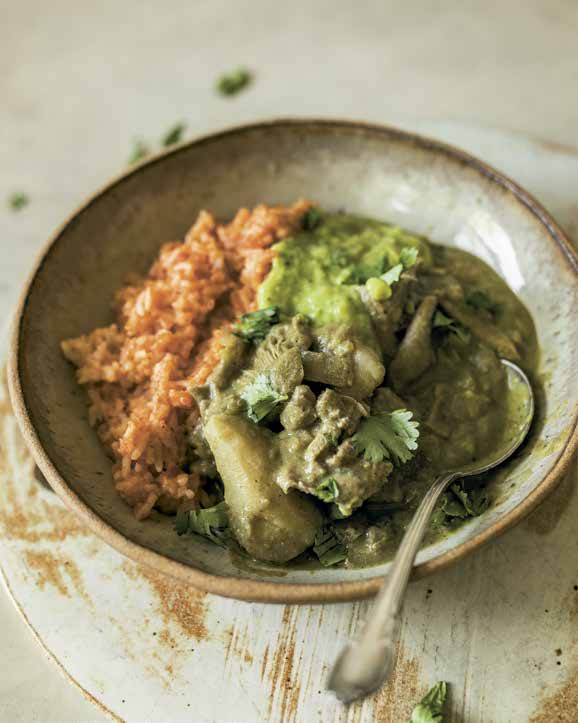Agriculture Alum Cooks Up A Following with Plant-Based Passion

Whether raising backyard chickens in Oakland as a child or rising before dawn to pick produce in college, Edgar Castrejón’s love for food and farming has always had a place at the table.
They’ve also become a recipe for professional success.
In October, Castrejón (Agriculture, ’18) published his first cookbook, Provecho: 100 Vegan Mexican Recipes to Celebrate Culture and Community, and it was immediately devoured—landing on “Top Cookbook” lists across the country. He’s been profiled in the Boston Globe, Smithsonian Magazine, and the San Francisco Chronicle, and was recently interviewed by Food & Wine Magazine and Bon Appetite.
People can’t get enough of his vegan cooking, it seems. He has nearly 150,000 followers on Instagram, where he blends striking photography, his down-to-earth attitude, and his passion for plant-based foods into engaging and educational posts.
“I want to get down to the nitty-gritty details. It’s not just about living long but well and with vitality. And to not have boring food,” he said, laughing. “I love eating.”
Some days Castrejón posts Reels of him rolling a burrito stuffed with tofu and pico, or perhaps a picture of enchiladas dripping with verde sauce and cashew crema. Other days he’s gushing over the beauty of avocado slices fanned out in a tortilla.
His passion for produce points back to his time at Chico State, which he chose for college because it was affordable and close to home. After transferring from Sierra College, he spotted students selling produce near Meriam Library and immediately applied for a job at the Greenhouse Unit at the University Farm.
He soon worked his way up to harvest manager and market manager for the Organic Vegetable Project (OVP). Castrejón enthusiastically spent the rest of his time as a Wildcat pulling weeds, planting seeds, and picking an abundance of produce.
“I wish I could go back today and work there a little every week,” he said, his eyes brightening at memories of making sauce with fresh heirloom tomatoes or plating a beet salad from root vegetables that had been in the ground just hours earlier. He eagerly details how he once made a vegan pizza entirely from the OVP—from the zucchini crust and bell pepper topping to the dried oregano and marinara, its only non-homegrown ingredients were salt and pepper.
Taking 16–18 units each semester with a focus on horticulture and plant science, and working as many hours as he could at the Farm, Castrejón didn’t have a lot of free time. But he couldn’t stop himself from taking pictures of food he cooked and writing recipes to share with OVP customers so they’d have ideas for what to do with the daikon and kohlrabi he was growing for them.
Raised in a meat-heavy household, it wasn’t easy to tell family members of his choice to be vegan. It made him somewhat of an anomaly in the College of Agriculture as well. A longtime vegetarian, when he was asked to fill in one day at the Organic Dairy Unit, the opportunity to be up close and personal with the cows helped him decide he was done incorporating animals into his diet. Prediabetic at the time, the switch also dramatically improved his health and he feels that he’s making a meaningful contribution to combating climate change.
Shortly before graduation, Castrejón was approached about a job as a food photographer and decided, “Why not?”
“I said, ‘I’m not going to tell her I don’t know how to do this—I’m just going to wing it until I do,’” he said.
It turns out, his kitchen photography talents were on par with his knife skills. Soon, someone asked him about writing a cookbook. He wrote 10 recipes, took photos, and composed a story pitch—landing a deal with Penguin Randomhouse. While he had to pivot the focus during the pandemic, focusing more on simple recipes with simple food, his family remained a refrain. He Facetimed them to talk about recipes, did contactless food drops at their homes for taste-testing, and reminisced with his parents about their childhood tastes in Mexico.
The resulting book is filled with inviting recipes, including a mushroom-based pozole, lentil-cauliflower empanadas, and jackfruit tinga tacos. He also spells out the ingredients for a well-stocked and flavorful plant-based kitchen.
The title of the book reflects Castrejón’s philosophy around food. While provecho is often interpreted as an invitation to enjoy food, the etymology comes from the Spanish word provechar, meaning “to make the most of.” And that’s what he tries to do with every meal. No matter how small or feast-worthy, he wants the food he makes to impart a sense of joy, an appreciation for community, and gratitude for what we share.
By offering up the traditional recipes of his childhood as seen through a plant-based lifestyle, he hopes each one conveys nostalgia and well-being, while also proving that Mexican meals don’t need meat, cheese, or other traditional tastes to be delicious and distinctive.
“My family and culture are my greatest inspiration,” Castrejón writes in Provecho. “Getting their seal of approval is the highest compliment and means more to me than any award.”
While he says he owes his greatest gratitude to his family and heritage, he’s also committed to honoring communities responsible for putting food on tables in the first place. He recently cooked for 400 people at a fundraiser that supports literacy programs in Arizona, and he also works with his clients to benefit Corazon Healdsburg in its work to support farmworkers, financial literacy, and prenatal care.
“The community is helping me, and I’m trying to help them back,” he said.
He’s now thinking about a second book and looking at master’s programs in public health and nutrition, while also consulting on restaurant menus and still sharing his world on Instagram. If Castrejón can dream it, he can do it, he’s decided. After all, that attitude has gotten him this far.
“Just be delusional. Think you are going to do something even though it doesn’t seem possible,” he said. “Today, my mom is so proud. And I am too. I love teaching people about these experiences and how to feed themselves.”
Here, Castrejón shares a recipe from Provecho that began as an experiment but quickly became a favorite. It’s a variation on the traditional red mole, which is made with ancho, pasilla, seeds, and chocolate, pipián is a brighter, fresher style made with poblanos and serranos.
“After countless calls with my aunts and grandma, searching for a good pipián recipe, I asked, ‘Why not make it our own way?'” he recalled. “Mi tias and abuelita hemmed and hawed. Most of them didn’t know the recipe by heart. . . . “So after much tinkering, I finally came up with this iteration at midnight. I made it with oyster mushrooms instead of the typical chicken and it was to live for!”

Recipe: Pipián or Green Mole
PREP TIME: 25 MIN. | COOK TIME: 30 MIN. | 6–8 SERVINGS
INGREDIENTS
- 8 small russet potatoes, peeled and halved
- 4 poblano peppers
- 2–4 serrano chiles
- 1 cup dry roasted assorted nuts (almonds, cashews, walnuts, pecans, etc.)
- 1/4 cup tightly packed cilantro leaves
- 3 cups low-sodium vegetable broth
- 2 tablespoons white vinegar
- 2 tablespoons avocado oil
- 8 ounces pink or white oyster mushrooms, roughly chopped
- 1 finely chopped white onion
- 6 garlic cloves, minced
- 1 1/2 teaspoons Sea salt
INSTRUCTIONS
- Bring 5 cups of water to boil. Add 1 teaspoon salt, 1 tablespoon of the vinegar, and potatoes. Reduce heat, cover, and simmer for 15 minutes. Drain and set aside.
- Meanwhile, place 1 poblano on a gas burner over medium-high heat. Turn occasionally with tongs until 50–75% of the pepper is charred (4 to 6 minutes for each poblano). Repeat with serranos (2 minutes on each side). Set aside to cool.
- In a blender, combine the nuts, cilantro, 1/4 cup of the broth, remaining tablespoon of vinegar and 1/2 teaspoon salt. Set aside.
- Peel most of the charred skin off the peppers (leave some to add a smoky flavor). Slice each poblano open, and remove and discard the seeds. Transfer peppers to the blender. Blend on high until smooth, about 1 minute. Set aside.
- Heat the avocado oil in a large skillet over medium heat. Arrange mushrooms in a single layer, working in batches if necessary to avoid overcrowding. Cook, undisturbed, until golden, about 3 minutes per side. They should be easy to flip once they are properly seared. Transfer to a bowl and set aside.
- Add the onions, garlic and 1/4 cup of the broth to the same skillet. Cook, stirring occasionally, for 5 minutes. Add the sauce, mushrooms, potatoes, and the remaining 2 1/2 cups of broth. Reduce heat, cover, and simmer until sauce thickens, about 15 minutes. Serve over Spanish rice, garnished with cilantro.


